In today’s fast-paced business environment, efficient project management is key to success. The right project management software can make all the difference, especially when it’s budget-friendly or free.
This comprehensive review focuses on the best free project management software available, detailing their standout features, strengths, and potential limitations.
Free project management tools compared
| Software | Availability | Free Version Limitations | Standout Features |
|---|---|---|---|
| Trello | Web, iOS, Android | 10 boards, 10 MB file limit, limited automation | Card-based tasks, customisable, user-friendly |
| Asana | Web, iOS, Android | 15 team members, no task dependencies, no timeline | Multiple project views, automated workflows |
| Jira | Web, iOS, Android | 10 users, limited project types, restricted storage | Agile management, customisable workflows |
| Monday.com | Web, iOS, Android | 2 team members, basic features, no Gantt charts | Customisable boards, time tracking |
| Wrike | Web, iOS, Android | 5 users, basic task management, no Gantt charts | Mix of traditional and agile features |
| ClickUp | Web, iOS, Android, Windows, Mac | Limited storage, reduced reporting, fewer integrations | All-in-one approach, customisable views |
| Zoho Projects | Web, iOS, Android | 1 project, no Gantt chart, limited issue tracking | Balance of features, integration with Zoho apps |
| Basecamp | Web, iOS, Android, Mac, Windows | 3 projects, 20 users, 1 GB storage | Combined project management and communication |
| Airtable | Web, iOS, Android, Mac | 1,200 records per base, 2 GB storage, no Gantt views | Spreadsheet-database blend, high customisability |
| Smartsheet | Web, iOS, Android | Spreadsheet-like functionality, limited collaboration | Familiar interface, automated workflows |
1. Trello

Trello is celebrated for its intuitive, card-based system, making project tracking visually straightforward and user-friendly. It’s particularly effective for small to medium-sized teams needing a simple yet flexible solution. Trello’s board, list, and card setup facilitate easy task organization and delegation. Users can customize boards with various backgrounds, labels, and add-ons to suit specific project needs. Trello integrates smoothly with many other tools, enhancing its versatility as free project management software.
Availability: Trello is accessible via web browsers, and has dedicated mobile apps for iOS and Android devices.
Standout features
- Card-based task management
- Customisable boards and cards
- Integration with various apps
- User-friendly interface
Limitations of free version
- Limited to 10 boards per team
- File attachments are capped at 10 MB per file
- No advanced features like custom fields, priority support, or timeline views
- Limited automation (only 50 command runs per month)
2. Asana
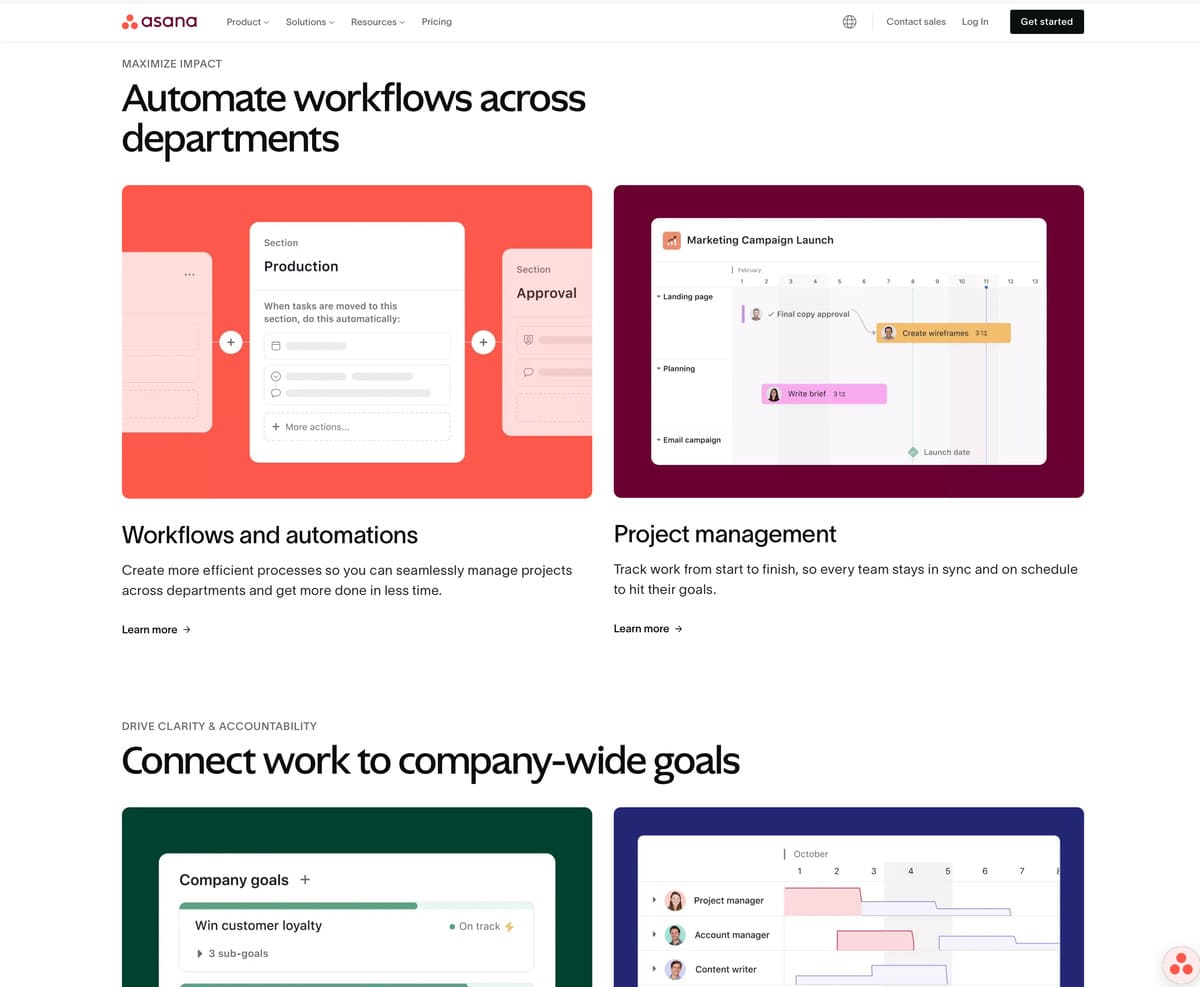
Asana is a versatile tool known for its clean interface and robust task management capabilities. It’s ideal for teams that require detailed planning and tracking. Users can view projects in a list, board, or calendar format, offering flexibility in project visualisation. Asana enables task assignments, setting priorities and deadlines, and allows for detailed subtasks and dependencies. The tool also features automated workflows and an extensive range of integrations with other apps.
Availability: Asana can be used through web browsers, and offers mobile applications for both iOS and Android platforms.
Standout features
- Multiple project views (list, board, calendar)
- Task dependencies and subtasks
- Automated workflows
- Extensive app integrations
Limitations of free version
- Task dependencies are not available in the free version
- Limited to 15 team members
- No timeline view for project planning
- Lacks advanced reporting and admin controls
3. Jira
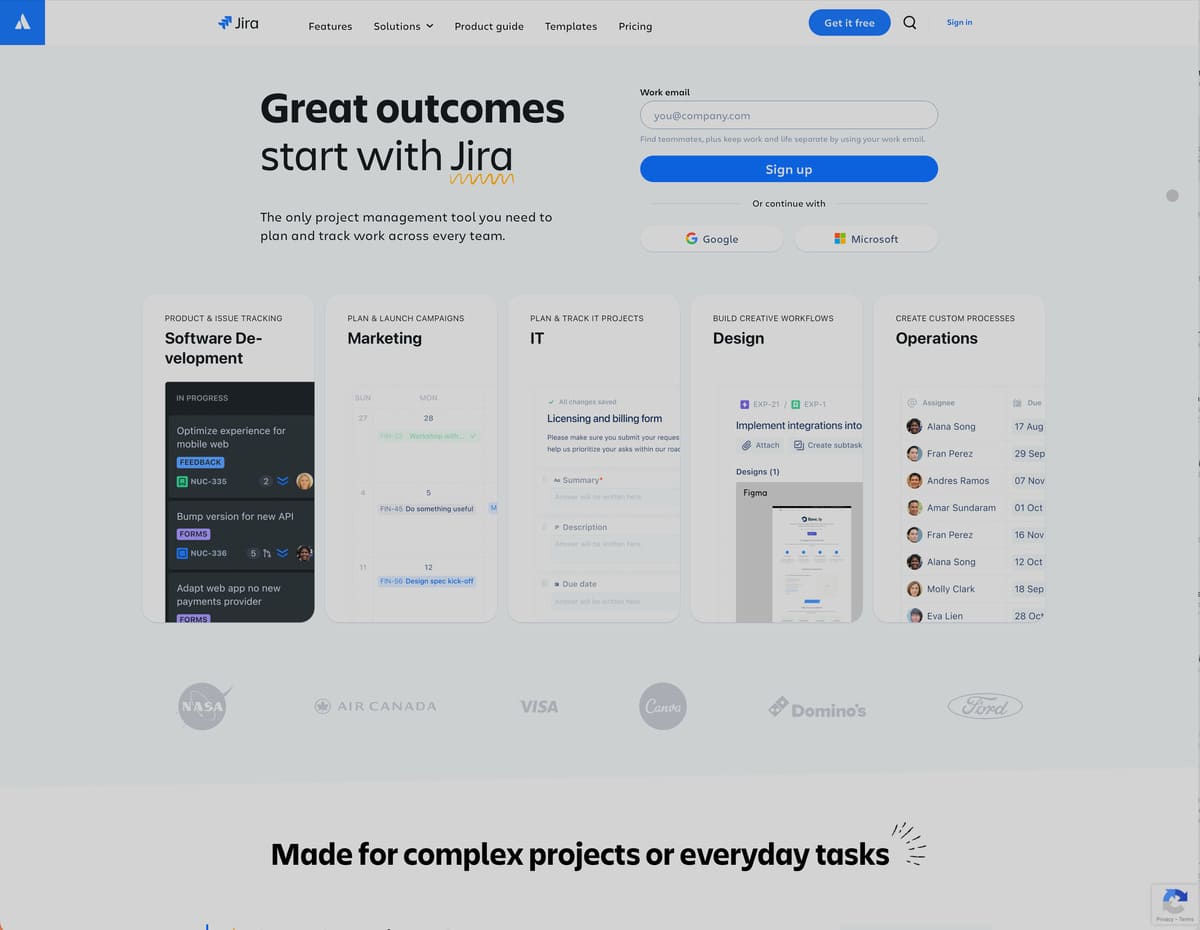
Jira, initially tailored for software developers, offers powerful tools for agile project management. It’s well-suited for teams that follow Scrum or Kanban methodologies. Jira’s issue and project tracking features are comprehensive, allowing for detailed reporting and analytics. The software supports custom workflows, a variety of reporting tools, and a vast marketplace of add-ons. However, Jira can be complex for beginners and might be more than needed for simpler projects.
Availability: Jira is available on web browsers and has mobile apps for iOS and Android, catering to a range of devices.
Standout features
- Agile management tools (Scrum and Kanban boards)
- Customisable workflows
- Detailed reporting and analytics
- Extensive marketplace for add-ons
Limitations of free version
- User limit of up to 10 users
- Limited project types and no access to advanced features like project archiving
- No access to premium features like advanced roadmaps and admin insights
- Restricted storage capacity
4. Monday.com
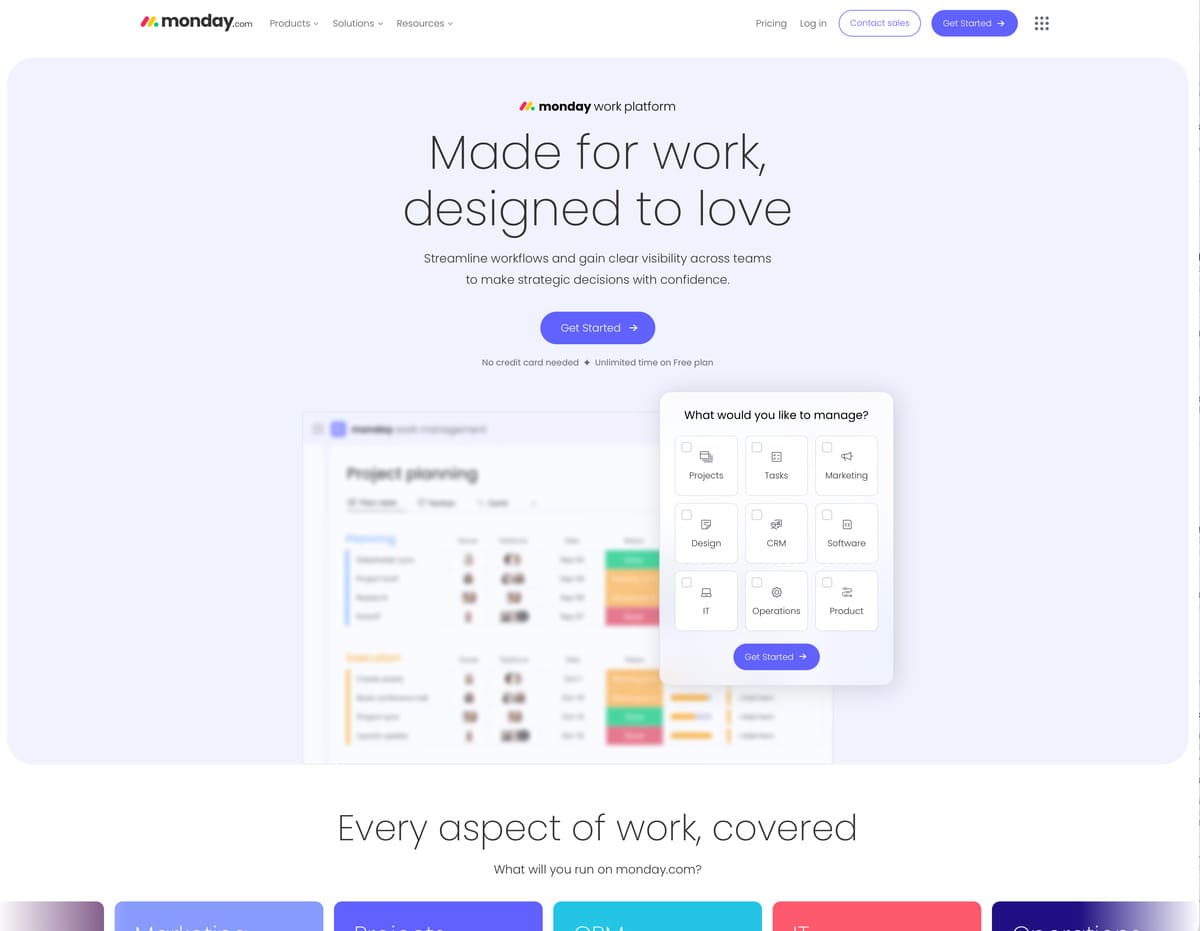
Monday.com is a highly customisable project management tool, catering to a wide range of business needs. Its user interface is visually appealing, and users can choose from a variety of templates to get started. The platform offers detailed project tracking with time and progress tracking features. However, the free version has limitations in terms of user count and the number of boards available. Monday.com integrates with several other tools, enhancing its functionality.
Availability: Monday.com can be accessed through web browsers, and features mobile apps for iOS and Android.
Standout features
- Highly customisable boards
- Variety of templates
- Time and progress tracking
- Integration with multiple tools
Limitations of free version
- Maximum of two team members per account
- Limited to basic features with no access to automation or integration
- No timeline or Gantt chart views
- Limited data storage and no guest access
5. Wrike
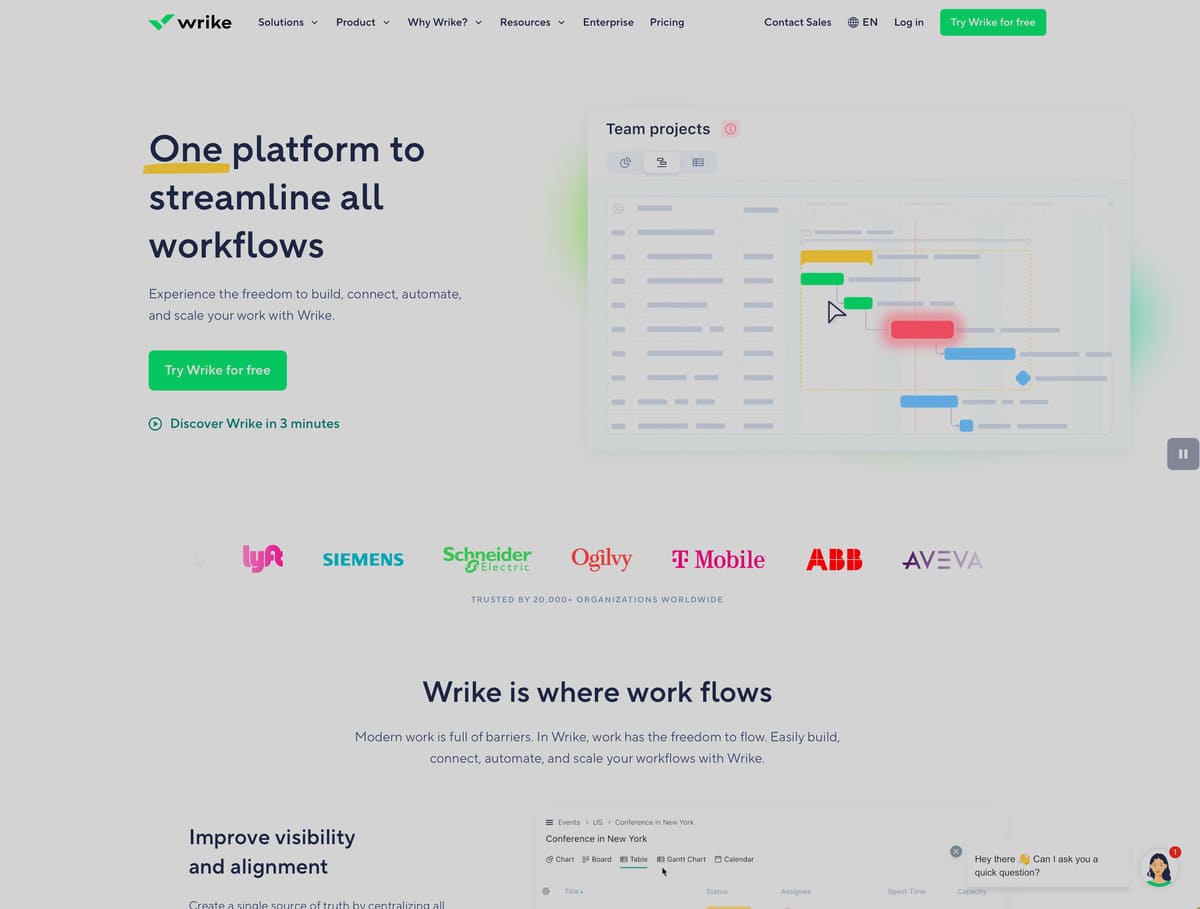
Wrike is a robust project management tool that scales well for larger teams and complex projects. It offers a mix of traditional and agile project management features, including detailed reporting and document sharing capabilities. Wrike’s interface is highly customisable, with features like Gantt charts, time tracking, and workload management. The software also has an advanced level of integration with other business tools, though it may require a steeper learning curve.
Availability: Wrike is accessible via web browsers, and provides mobile applications for iOS and Android users.
Standout features
- Traditional and agile project management features
- Customisable interface with Gantt charts
- Time tracking and workload management
- Advanced integration capabilities
Limitations of free version
- User limit of up to 5 users
- Limited to basic task management features with no subtasks
- No Gantt charts, time tracking, or advanced integrations
- Limited sharing and collaboration options
6. ClickUp
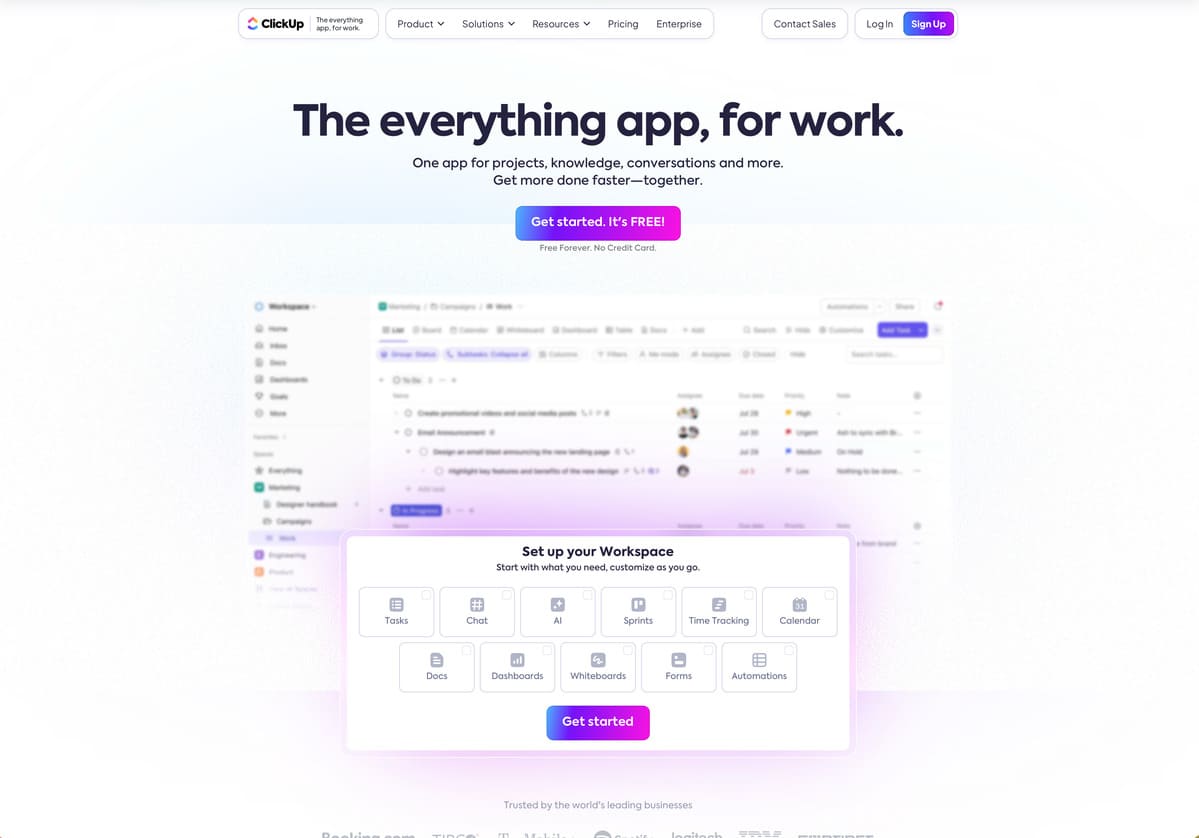
ClickUp is rapidly becoming a favourite for its all-in-one approach to project management. It combines traditional project management features with document storage, time tracking, and goal setting. The tool is highly customizable and offers a range of views for projects, including lists, boards, and calendars. ClickUp’s collaboration features are robust, including commenting and document sharing capabilities. It also offers a variety of integrations with other productivity tools.
Availability: ClickUp is available on web browsers and offers mobile apps for both iOS and Android, as well as desktop apps for Windows and Mac.
Standout features
- Combines project management with document and time tracking
- Customisable views (list, board, calendar)
- Robust collaboration features
- Wide range of integrations
Limitations of free version
- Limited storage space
- Restricted features in views and dashboards
- Limited reporting features
- Fewer automation and integration options compared to the paid versions
7. Zoho Projects
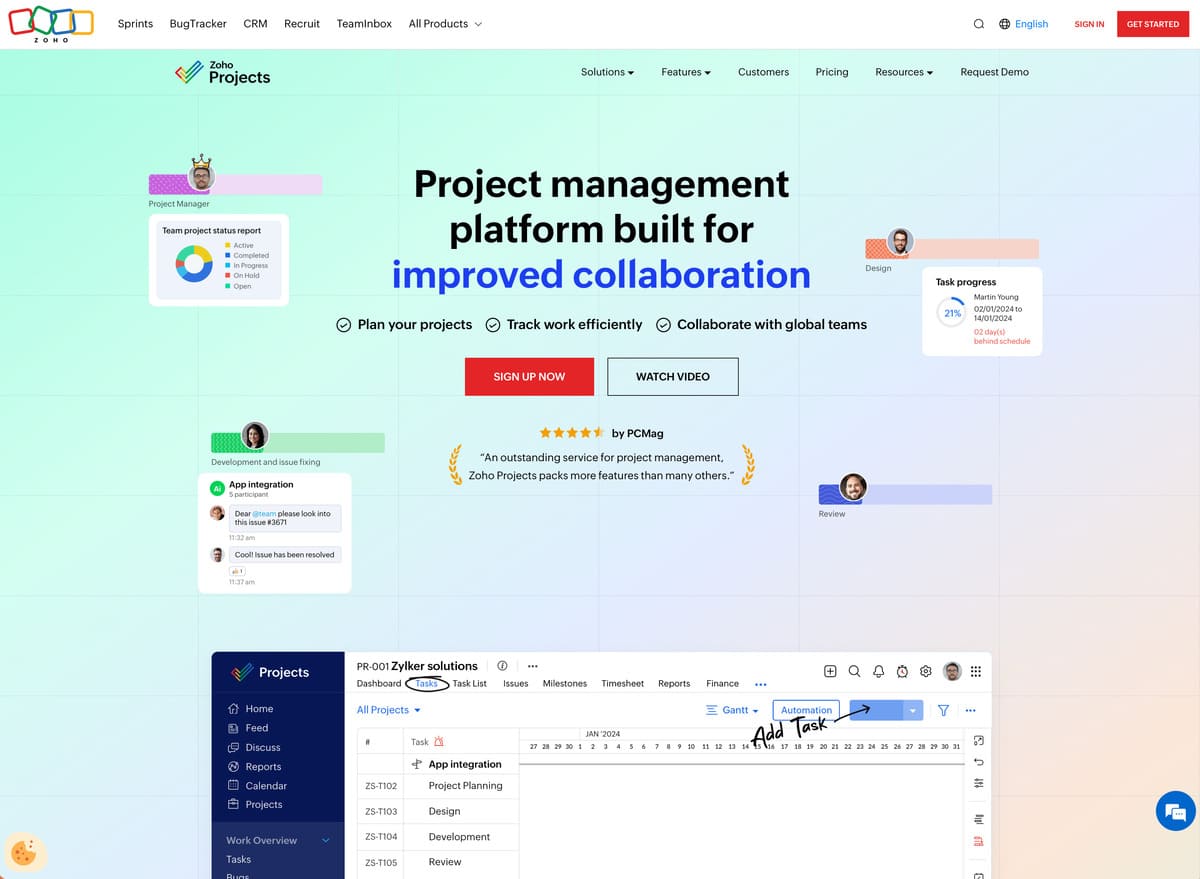
Zoho Projects is a part of the Zoho suite, known for its range of business and productivity applications. It strikes a balance between comprehensive features and user-friendliness, making it suitable for a variety of project types. The tool offers task management, time tracking, and collaboration features, along with Gantt charts for project planning. Zoho Projects also integrates well with other Zoho apps and various third-party tools.
Availability: Zoho Projects can be used through web browsers, and has mobile apps available for iOS and Android devices.
Standout features
- Comprehensive task management and time tracking
- Gantt chart for project planning
- Seamless integration with Zoho suite and other tools
- User-friendly interface
Limitations of free version
- Limited to one project
- No Gantt chart view
- Limited features in issue tracking and document management
- Reduced number of templates and limited integration options
8. Basecamp

Basecamp offers a unique combination of project management and internal communication tools. Its focus on centralising project information and team communication makes it ideal for teams looking for streamlined project tracking and discussion in one place. Basecamp features to-do lists, file storage, deadlines,
and team chat rooms. While its project management capabilities are simpler than some competitors, its strength lies in consolidating communication and project information.
Availability: Basecamp is accessible via web browsers and offers mobile apps for iOS and Android, along with applications for Mac and Windows.
Standout features
- Combined project management and communication tools
- To-do lists and file storage
- Integrated team chat rooms
- Simple and intuitive interface
Limitations of free version
- The free version, Basecamp Personal, is limited to three projects
- User limit of up to 20 users
- Only 1 GB of storage space
- No advanced features like project templates or client access
9. Airtable
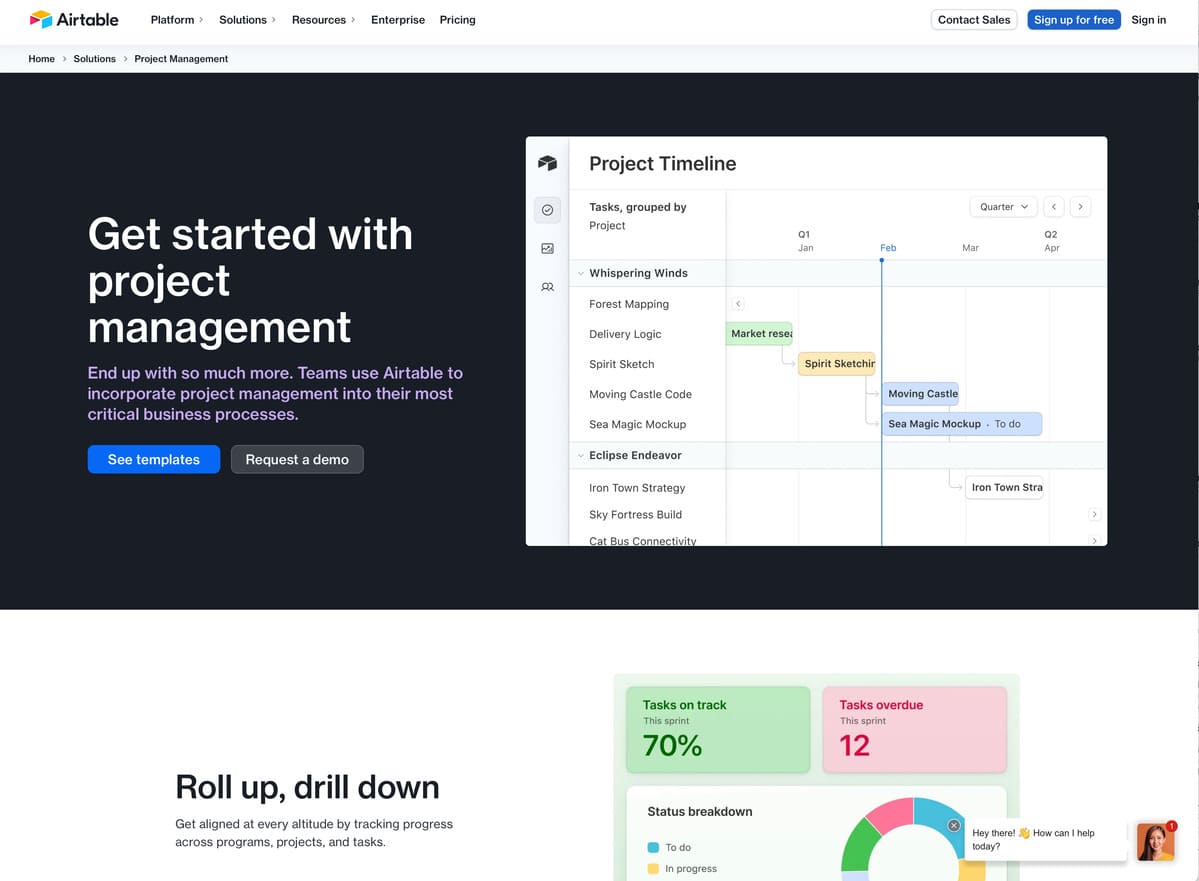
Airtable stands out with its unique blend of spreadsheet and database functionality. This combination allows for a high degree of customization and flexibility in project management. Users can create and link tables for different project aspects, and the interface is intuitive for those familiar with spreadsheet software. Airtable also includes features like different views (grid, calendar, Kanban), form builders, and a wide range of integrations.
Availability: Airtable can be used through web browsers, and has mobile applications for iOS and Android, along with a desktop app for Mac.
Standout features
- Blend of spreadsheet and database functions
- High customisability
- Multiple views (grid, calendar, Kanban)
- Extensive integration options
Limitations of free version
- Limited to 1,200 records per base
- Storage limit of 2 GB per base
- No access to Gantt chart and timeline views
- Lacks advanced features like custom branded forms and enhanced permissions
10. Smartsheet
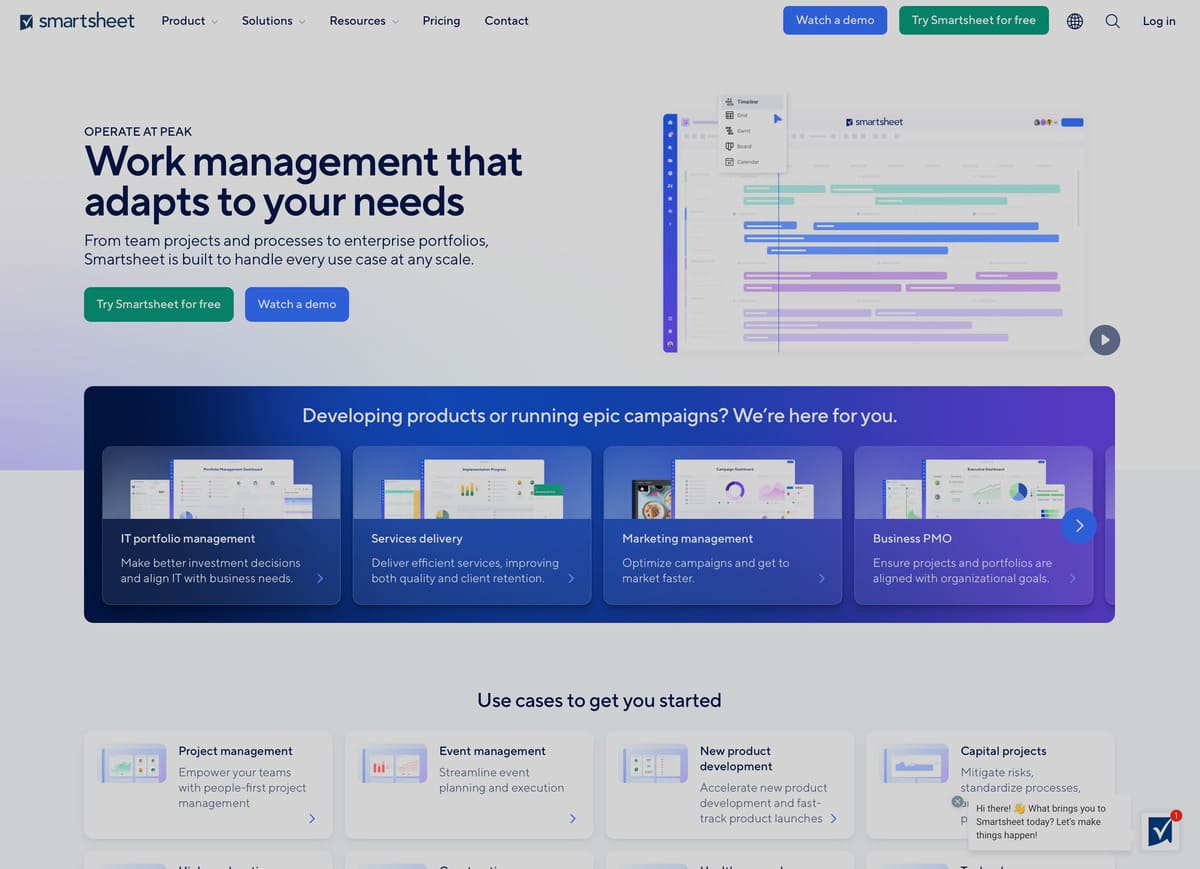
Smartsheet merges the familiarity of spreadsheet software with advanced project management features. It’s particularly suitable for those accustomed to Excel but seeking more functionality. Smartsheet offers features like Gantt charts, automated workflows, and collaboration tools. Its strong point is the ease of transition for users familiar with traditional spreadsheet applications, with added project management capabilities.
Availability: Smartsheet is available via web browsers, and provides mobile apps for iOS and Android platforms.
Standout features
- Spreadsheet-like interface
- Gantt charts and automated workflows
- Easy transition for Excel users
- Robust collaboration tools
Limitations of free version
- Limited functionality, primarily as a spreadsheet tool without advanced project management features
- No access to features like automated actions, dashboards, and reports
- Limited collaboration options
- No integration with other tools and limited customer support
Conclusion – Choosing a free project management software for your business
Selecting the right free project management tool is pivotal for enhancing team productivity and project success. The decision largely depends on your business’s specific needs, team size, project complexity, and preferred work style. Here are key considerations to help you make an informed choice:
- Assess Your Requirements: Identify the key features you need – like task tracking, collaboration, reporting, or integration with other tools. This helps in narrowing down the options to those that match your business requirements.
- Consider Team Size and Scalability: Some tools have user limits in their free versions. Choose a tool that not only fits your current team size but also can scale with your business.
- Evaluate Ease of Use: The tool should be intuitive and user-friendly. A steep learning curve can hinder adoption and productivity, especially for teams new to project management software.
- Platform Availability: Ensure the tool is accessible across the devices and operating systems your team uses. This enhances flexibility and allows team members to stay connected and productive, regardless of their location.
- Understand the Limitations: Free versions come with limitations. Be aware of these constraints – whether it’s in terms of features, storage, or user capacity – and how they might impact your team’s workflow.
- Future Upgrade Paths: Consider the upgrade costs and additional features of paid plans. As your business grows, you might need more advanced features, so it’s wise to choose a tool with an upgrade path that aligns with your future needs.
- Trial and Feedback: Most tools offer a free version or trial period. Use this opportunity to test out a few options. Gather feedback from your team on usability and effectiveness to make a collective decision.
In conclusion, there is no one-size-fits-all when it comes to free project management software and tools. The best choice is one that aligns with your business’s operational style, enhances efficiency, and is embraced by your team. By considering these factors, you can select a tool that not only manages your projects effectively but also contributes to the overall growth and success of your business.

